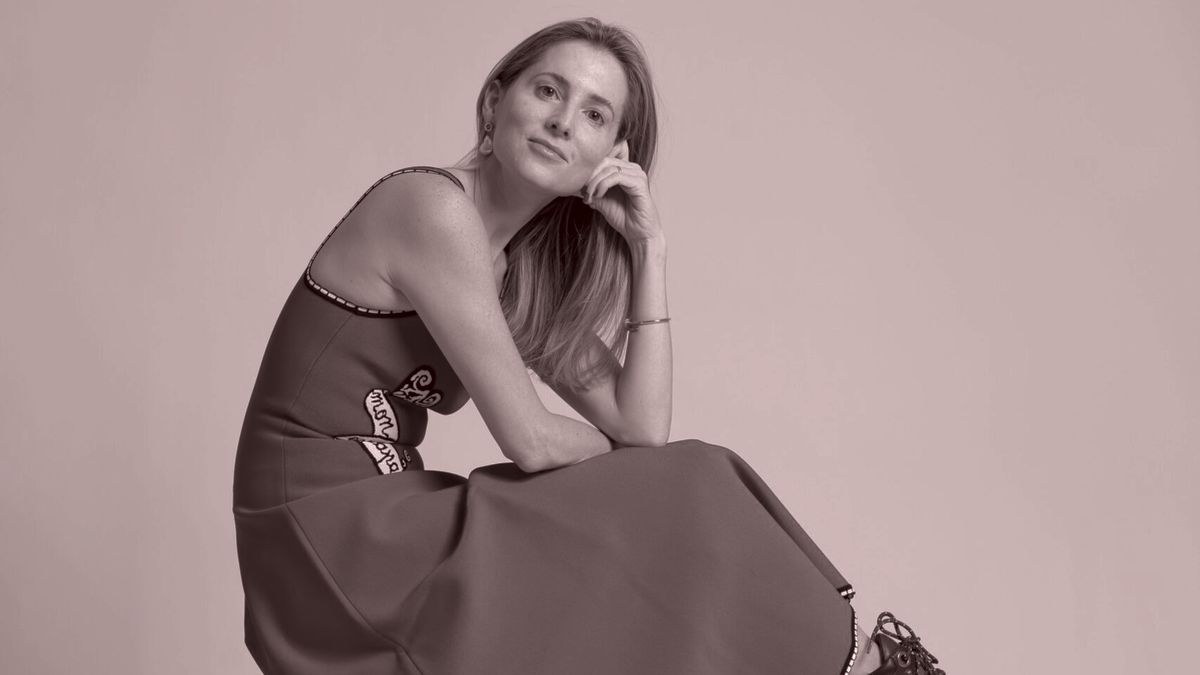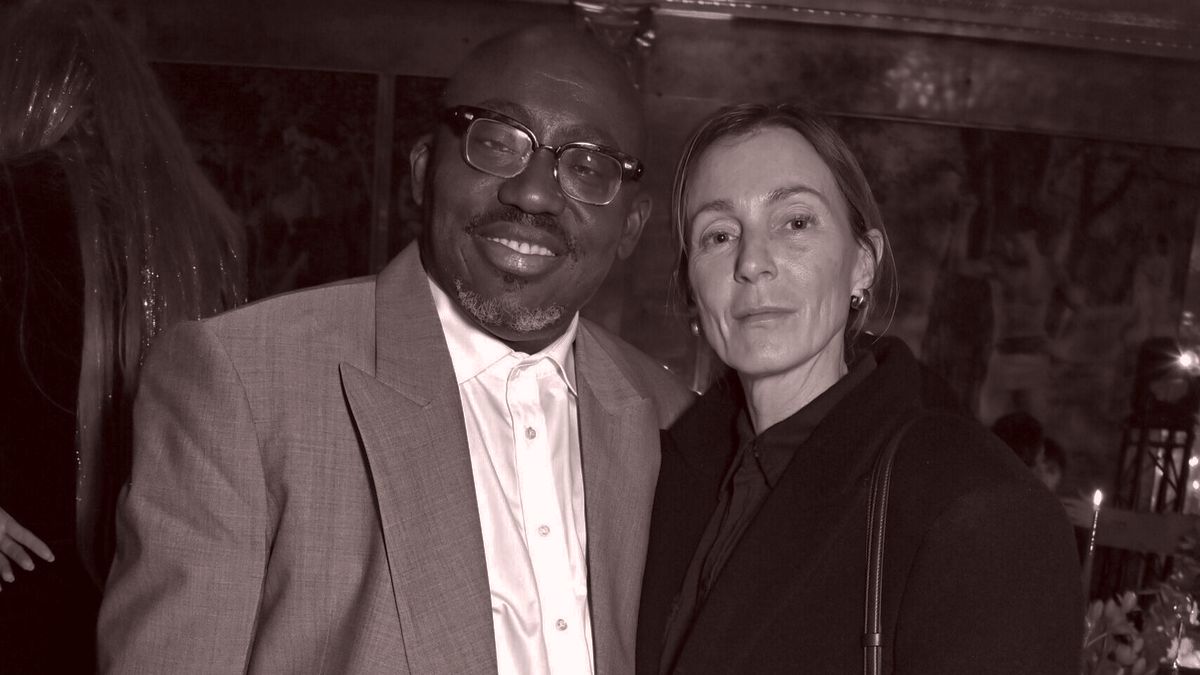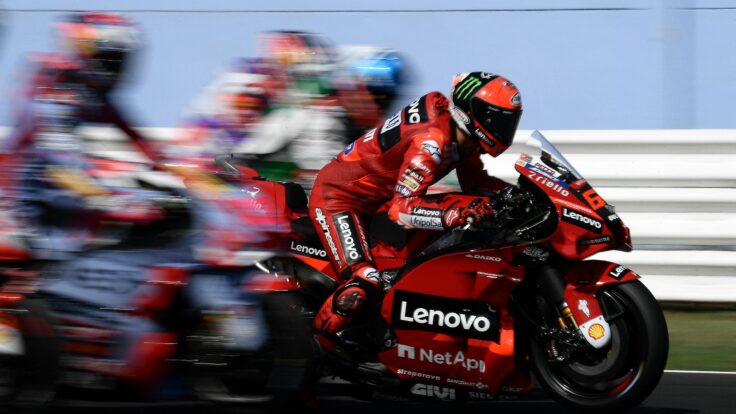Hi, and welcome back to Line Sheet, your number-one source for
LuxExperience jokes. (Okay, okay, let’s just say we’re thrilled that only the parentco has been renamed, and Mytheresa and Net-a-Porter are here to stay.)
It’s earnings season, baby! So, today, we have
some things to say about LVMH’s Q4 2024. Plus, our retail expert Sarah “SShapiro@puck.news” Shapiro is on the beat with a note about the alleged skinny jeans revival—I know that the Prada men’s collection made many of you angry, but when
they’re right, they’re right—and an analysis of Taylor Swift’s sudden penchant for mega-labels in an era when they feel mega-lame.
For today’s main event, Sarah digs into the good and not-so-good of former fashion editor Marina Larroudé’s fast-growing label, Larroudé. As many of you know, shoes may feel like an easyish sell, but name brands rule this category more than any
other, so it’s a marvel that Larroudé and her husband-business-partner, Ricardo, have managed to crack $60 million in annual sales in less than five years.
Finally, I’ve got some updates on how you can help support Los Angeles right now: Eckhaus Latta co-founder Zoe Latta opened an online shop to raise money to support firefighters; jeweler Sarah Hendler is donating 100 percent of the proceeds of her hearts-heavy collection to a trio of good causes; and Danielle Sherman is doing the same for a selection of Sherman Field pieces.
Mentioned in this issue: Marina Larroudé, LVMH earnings, Tiffany, Richemont, Takashi Murakami, Louis Vuitton, Zendaya, Taylor Swift, Blake Lively, LuxExperience, Quince, Alix Earle, the skinny jeans “revival,” Demna, Kim Jones, Burberry,
Pharrell Williams, Plum Sykes, and many, many more.
|
Three Things You Should Know…
|
- Not too bad, eh?: LVMH reported better-than-expected fourth quarter and full-year 2024 results on Tuesday, beating analyst projections to reach €84.68 billion in revenue, up 1 percent on an organic basis from a year earlier. The gist is that the fourth quarter was decent for certain segments of the luxury industry—fine jewelry, in particular. (Remember that Richemont, owner of Cartier and Van Cleef & Arpels, “smashed” expectations?) Reading between the lines of the LVMH press
release, it’s clear that Sephora once again absolutely murdered, with organic sales up 6 percent, and that the fashion and leather goods division, despite some struggles, still made €41 billion, with “operating margin remaining at an exceptional level.”
Sales increased in Europe and the U.S., partially making up for the continued China problem. Meanwhile, wine and spirits dragged, with operating margin down 36 percent. (Darn cognac!) In fine jewelry, the company spotlighted Tiffany,
including the success of its collaboration with Pharrell Williams and the “record-breaking revenue” at the New York Fifth Avenue flagship, whose disgruntled employees were the subject of a recent Bloomberg exposé. (I’ll have more on Tiffany in my Thursday email, exclusively for
Inner Circle members.) Revenue from high jewelry—the expensive kind—has quadrupled since LVMH bought Tiffany in 2021, and operating profit has doubled.
Bernstein’s Luca Solca, the industry’s leading analyst, was encouraged by the results, but not convinced that everything is going to be okay, noting that the company still has “work to do” on Dior,
and that Richemont’s numbers were so good that it made LVMH’s output look less impressive by comparison. From my view, it’s important to remember that the only apples-to-apples comparison here is Tiffany and Cartier. And even if Cartier is still winning, Tiffany is gaining ground. I’d also point out that Richemont’s fashion brands are succeeding because they are small, specific, and elicit desire among consumers. LVMH’s brands are giant by comparison, but there is a lesson for the
conglomerate in the success of Chloé and Alaïa: People don’t want generic stuff.
We’ll see whether the group’s new designer appointments and merchandising strategies reflect that understanding over the next six months, particularly as several new creative directors release collections. That said, I expect the first quarter to be really good in the fashion and luxury goods division, buoyed by Louis Vuitton’s Takashi Murakami relaunch, which I’ve heard has been a
blockbuster success that far exceeded internal expectations. No surprise that, in the financial presentation deck, the 2025 outlook slide was littered with images of the Zendaya-fronted campaign.
|
|
|

|
Sarah Shapiro
|
|
- On Taylor’s
luxury experiment: For years, Taylor Swift had her own fashion code whereby she resisted pay-to-play opportunities and generally avoided wearing prominent labels. But ever since Taylor’s inner circle included Travis Kelce and Blake Lively, two clotheshorses with views on fashion, her style has evolved from “Anthropologie girl gone wild” (Lauren’s coinage) toward… label lover gone loopy? During Sunday’s AFC championship game, Swift
wore a Louis Vuitton zip-sweatshirt as an epilogue to the previous Saturday’s Chanel runway look. Indeed, her off-duty approach has evolved a great deal from last year’s Area denim, Guest in Residence red sweater, and vintage Chiefs sweatshirts.
At 35, Swift has reached a threshold where many
women naturally graduate from contemporary to luxury fashion. Sarah Chapelle, author of the bestselling Taylor Swift Style, suggested that Swift might be playing a long game, dressing for slideshow posterity and hoping to demonstrate a contrast from last season’s looks. In that context, it makes sense to distinguish one winning season from the next, particularly since the Chiefs could very well make history by winning three consecutive Super Bowls.
Unlike
other celebs who jump into fashion deals for the paycheck or wear designer clothes to get a brand’s attention, Swift can be purely herself, or as purely herself as a global mega pop star can ever be in public. While she has often worn brands like Reformation, Zimmermann, and Paige, lately it’s been Chanel, Louis Vuitton, and Balmain. (Regrettably or not, she’s kept her signature
Pat McGrath red lip through it all.) Swift is doing all this because she can, of course, and because it’s fun, but it’s also a reflection of her new life stage.
- The skinny jeans conspiracy: The latest in the denim silhouette discourse has focused on Frame’s ostensibly popular collab with influencer Alix Earle for
“The Alix”—a skinny leg jean that quickly sold out and inspired bold claims that the style is back in vogue. But I’ve come across some countervailing evidence—or, at least, some red flags about the theory. To start, while Frame confirmed that the style sold out, I would need to see the purchase order and inventory recap to determine whether the cause was popularity or paucity. Also, Frame sold the
product for $128 and $148, a steep discount compared to its other styles. Did these jeans sell because everyone wanted a pair of skinny legs, or because consumers were picking the least expensive option?
Also, something else may be afoot. Yesterday, The Wall Street Journal covered Levi’s data partnership with Google
Cloud, which allowed the historic denim maker to confirm the rising popularity of its looser fit jeans—and not just among Zoomers. As I scour the market, it’s increasingly clear that there isn’t a single prevailing denim trend. Instead, each season offers a few hero silhouettes that contribute fresh takes—bubble, lasso, horseshoe, etcetera—and people nevertheless tend to buy what they like and what makes them feel good.
|
|
|
The upstart shoe brand admits it’s experiencing growing pains in its attempt to
reinvent—or at least adjust—the way big retail operates. But if their vertically integrated model works, it could yield a cleaner, leaner end-to-end supply chain that its big-name rivals can only fantasize about.
|
|
|
When Marina Larroudé and her husband launched their namesake company
Larroudé, back in 2020, they pitched the shoe brand’s innovative model—a quality product that was distributed via quick drop-ship delivery, all vertically integrated, with the shoes moving from the factory floor to the customer’s home in a matter of weeks. Larroudé, herself, also had a story to sell: She was a well-liked fashion insider who had worked at Barney’s, the shoe brand Schutz, Style.com, and Teen Vogue. Her finance guy husband, Ricardo, joined her as
C.E.O. to stand up the company’s operations and give the brand some business cred. The Larroudés didn’t take on meaningful institutional money, and instead self-financed and raised capital from friends and family, giving the couple the ultimate control and ability to do their thing.
More than four years later, Larroudé has remained true to its promise, with a business model that aims to create a
nimbler, more efficient, less wasteful way of operating a fashion company. Larroudé owns its factory in Brazil, which it opened in 2023, and has some 200 employees. Meanwhile, I’ve heard estimates that Larroudé was on pace to make $60 million in sales last year—a meaningful accomplishment for a startup in a market dominated by endlessly capitalized name-brand players. (The company declined to comment on its revenue.) It has largely succeeded by making shoes that are approachable for work and
casual dressing, like the Blair, a Mary Jane ballet flat that comes in more than a dozen fabrications, and the Dolly, a 4.5-inch block heel with a 1.5-inch platform.
Even though 80 percent of Larroudé’s business
is direct to consumer, fashion is a multichannel industry, and drop-shipping is an enhancement to wholesale, not a replacement. And Larroudé, as a small brand, had to deal with plenty of the headaches that plague other, far larger businesses that work with department stores, too. Retail, after all, is a system that tends to reward deep-pocketed manufacturers that can afford to make products many quarters in advance of their sale, wait months for payments, and absorb
returns—like the dreaded R.T.V., or return to vendor—and discounts on unsold products. Marina Larroudé acknowledged “hundreds of thousands” in delayed payments from both Saks and Neiman Marcus, surmising that the slowdown stemmed from their merger. (Saks declined to comment.)
Anyway, in late 2024, the company changed its wholesale strategy to mimic its D.T.C. roots, pivoting away from taking large wholesale orders preseason
and instead working with department stores and larger boutiques to maintain inventory control, only shipping products after they’d sold through the retailer’s website. Instead of placing orders six months in advance, they would just sell what was available from their inventory. It was a seemingly small pivot, but also a big one in a hidebound industry. “I do think it takes someone who is an outsider,” Marina told me recently, regarding the couple’s decision to drop-ship-ify their wholesale
business.
|
Larroudé’s accordioned supply chain dramatically reduced the risk of a wholesale partner
ending up with shoes nobody wants. “We are able to produce in between two and three weeks’ time,” Marina told me. “Which is insane if you compare it to the major footwear brands. They take at least six months, sometimes a year, to get a reorder in, right? So we really changed the game in that sense.” The strategy had other perks, too. “If they have a shoe that is not selling, and they decide to put that on a markdown, at the end of the day it’s jeopardizing our brand,” Marina said. “So for us,
it’s better if we have access to see what performs, and then we’re gonna produce more.”
Of course, there were setbacks as well. The company did more business in November 2024 than all of 2022, but the high volume led to shipping holdups, delayed refunds, and uneven customer support. Most of the volume came from the company’s D.T.C. channels, but it was hard to contain. Some of those gripes would
eventually find their way onto Larroudé’s Instagram account.
Indeed, small forecasting misses can result in meaningful delays. But rather than communicate those delays to consumers this past quarter, it seems they just… hoped it would get better. Larroudé did offer credits to customers, but the resulting social media comments were a mess. Since then, the company has been ramping up its customer
service—Marina and Ricardo were also jumping in to help handle complaints themselves—and looking for additional support. In any event, it could not have been a restful holiday for the couple.
Larroudé’s growing pains highlight just how hard it is to reinvent the traditional retail model. But the company’s also tackling the industry’s biggest headaches head-on. Yes, yes, they still need to solve their operational
challenges, but the shift away from traditional wholesale could provide a new blueprint for inventory management. In an industry grappling with inventory issues, delayed payments, and changing consumer expectations, their experiment is admirable. Whether or not they succeed, they’re showing the industry what the future of fashion retail could look like.
|
What
We’re Reading… and Listening To…
|
Some lessons on the importance of fresh inventory and more from Mytheresa
(LuxExperience? 😬) C.E.O. Michael Kliger. [What’s Contemporary Now]
Quince—which is on the road to being an online Kirkland, a.k.a. Costco’s private label—is expanding into fragrance, supplements, and more men’s categories. [Modern Retail]
Sabyasachi invited what feels like half the international fashion industry to Mumbai for its 25th anniversary runway show. It’s early days, but this is definitely in the running for top press trip of 2025.
[Elle]
This past week, Demna was awarded France’s Order of Arts and Letters, and Kim Jones was awarded the Legion of Honor.
[WWD and WWD]
Plum Sykes launched a Substack!
[PS by Plum Sykes]
Pete Nordstrom and Burberry C.E.O. Joshua Schulman offer an essential lesson in sock styling. [The Nordy Pod]
|
And finally… Can we talk about former WSJ. and T magazine
editor Deborah Needleman’s baskets?
Until tomorrow,
Lauren
P.S.: We are using affiliate links because we are a business. We may make a couple bucks off them.
|
|
|
Puck fashion correspondent Lauren Sherman and a rotating cast of industry insiders take you deep behind the scenes of this
multitrillion-dollar biz, from creative director switcheroos to M&A drama, D.T.C. downfalls, and magazine mishaps. Fashion People is an extension of Line Sheet, Lauren’s private email for Puck, where she tracks what’s happening beyond the press releases in fashion, beauty, and media. New episodes publish every Tuesday and Friday.
|
|
|
Unique and privileged insight into the private conversations taking place inside boardrooms and corner offices up and down Wall Street,
relayed by best-selling author, journalist, and former M&A senior banker William D. Cohan.
|
|
|
Need help? Review our FAQ page or contact us for assistance. For brand partnerships, email ads@puck.news.
You received this email because you signed up to receive emails from Puck, or as part of your Puck account associated with . To stop receiving this newsletter and/or manage all your email preferences, click here.
|
Puck is published by Heat Media LLC. 107 Greenwich St, New York, NY 10006
|
|
|
|


























